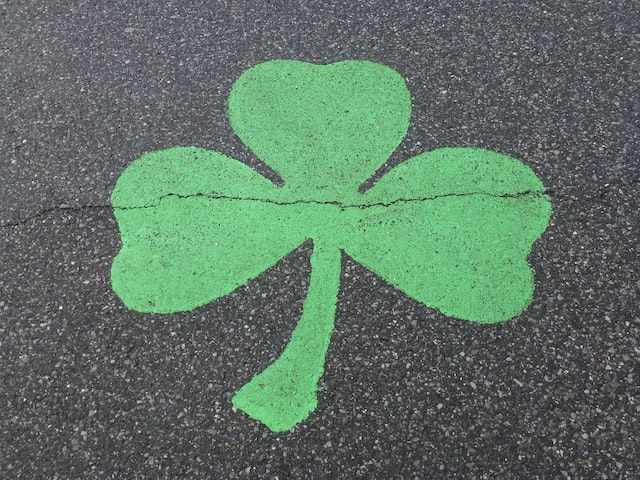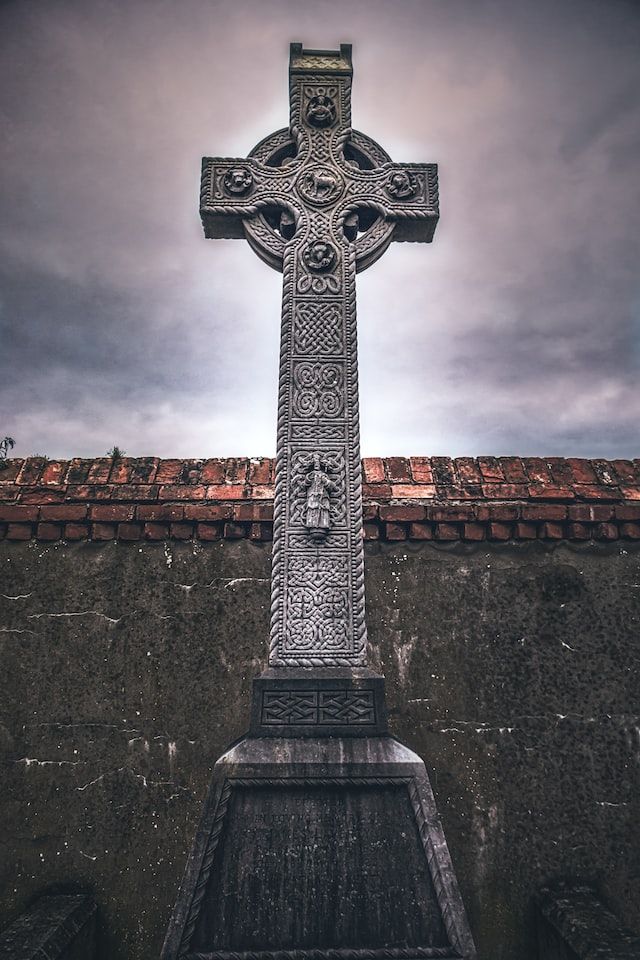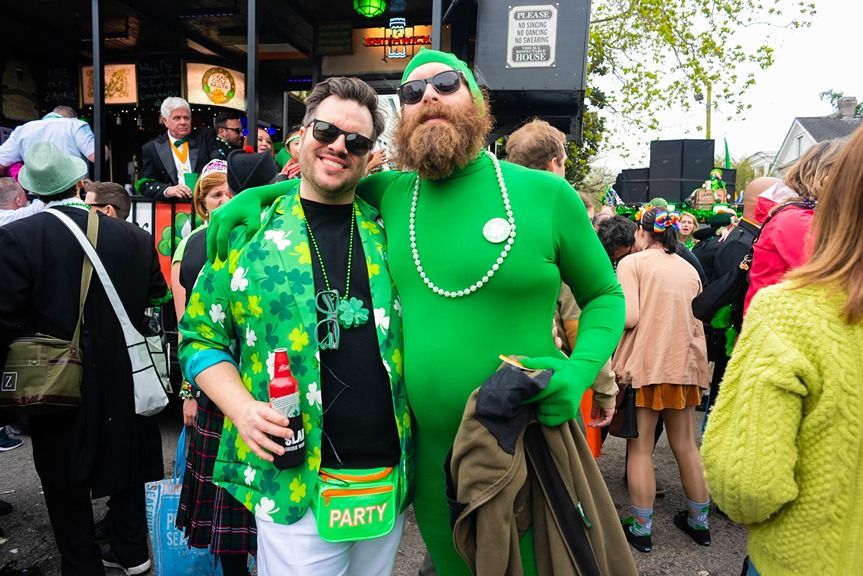New Orleans' Historic Irish Roots

St. Patrick's Day in New Orleans promises fountains of green beer and all the corned beef and cabbage you can eat. Green beads and moon pies fall from the skies (or at least from the floats), and the entire fixings for a traditional Irish stew rain down on you during any of the five parades dedicated to the occasion. It is definitely a good excuse to party.
In fact, many see Saint Patrick's Day as merely a continuation of Mardi Gras, since it follows so closely behind the end of Carnival Season. For some, it's a last hurrah before the sweaty summer months arrive, when the city slows down and things aren't nearly as much fun for awhile.
But why is this particular holiday such a big deal here in New Orleans? Why do we have the largest St. Patty's Day celebration of any city in the country, complete with ten days of parades, parties, balls, pageants and various other Irish-themed festivities? It's easy enough to attribute that fact to the inherent laid-back, party-loving, laissez-les-bons-temps-rouler attitude prevalent in New Orleans. But it's so much more than that. Saint Patrick's Day is also about Irish culture, history, and ethnic pride. It's about shared memories—not all of them good ones—and the common origin of a people: all that the Irish went through to get here and their many contributions along the way.
So Happy St. Patrick's Day! Don't take that green beer for granted, though. Not to rain on your St. Patty's Day parade or anything, but… When you raise your beer stein to toast to the luck of the Irish, remember that the Irish weren't always so lucky.
A Rough History

As early as the 1700's, the Irish began fleeing Ireland. They were suffering under British rule, and were trying to escape religious and political persecution at the hands of the British. New Orleans seemed like an appealing alternative. It was a major port, therefore many ships were headed there anyway, so the trans-Atlantic trip was often cheaper and more accessible. But the Irish also felt a kinship with the French and Spanish living here at the time, their common bond being a shared hatred of the British. They began flocking to New Orleans in search of happier things, often leaving their families behind and attempting to make a go of it, broke and alone.
Man shall not live by bread alone. But potatoes, yes. Man can and did live on potatoes alone… if, that is, he was Irish and alive in the 1800's. Two thirds of the Irish population during this period survived on a diet of exclusively potatoes, Ireland's predominant crop. In fact, the average Irishman back then ate 14 pounds of potatoes every day. That's the equivalent of more than 37 orders of McDonald's large French fries! But then all hell broke loose when a disease struck and destroyed the potato crop. The potatoes ended up all black, mushy and rotten… so much so that apparently even pigs wouldn't eat them. And even McDonald's wouldn't have dared serve them. This led to the tragic and disastrous Great Famine of the 1840's and 1850's, which killed a million Irish citizens. With no assistance from their cruel British wardens, the Irish had no choice but to get out of dodge to save themselves and immigration to America increased exponentially.
Irish in NOLA

By the 1830's, New Orleans was already the second largest port in the country. And the Irish accounted for half of all the immigrants pouring into the city. But this was just the beginning. During the worst years of the Great Famine — between 1845 and 1860, nearly two million Irish immigrants arrived in the U.S., at least 415,000 of whom ended up in New Orleans. By 1860, one of every five New Orleanians was Irish.
Saint Patrick's Day is definitely more than just a single day of the year here in New Orleans.
The Irish often travelled on ships as human cargo in less than first-class or fancy accommodations. The trip from Ireland was long, cramped, smelly and miserable. It took anywhere from 40 to 60 days in unclean and uncomfortable conditions, and many immigrants died along the way. Those who survived and reached New Orleans still had it pretty rough.
They faced poverty, discrimination, fraud and disease. They lived in slums in an area near the river which came to be called (and still is today) the Irish Channel, because so many of them congregated there. They took any job they could find in order to make a living, the most notable of which was the degrading and dangerous work of digging the New Basin Canal. Even in the midst of the worst yellow fever epidemic in New Orleans' history, in 1853, the Irish put themselves in jeopardy to dig a huge canal that ran from the Mississippi River to Lake Pontchartrain. They worked for endless backbreaking hours digging by hand through swamps swarming with yellow-fever-carrying mosquitoes. Conditions were so bad that even slaves were spared from this work. Anywhere from 4,000 to 30,000 Irish people were killed building the canal. And to add insult to lethal injury, the New Basin Canal was filled in after World War II to make way for the Pontchartrain Expressway.
Through perseverance and a little bit of luck, the Irish eventually managed to make a decent life for themselves in New Orleans. Along with digging canals, they built English-speaking churches, served in the military and founded major banks. They worked as laborers, businessmen, skilled artisans, dockworkers, domestic servants and priests. They greatly contributed to the architecture, design, food, music, dance and general spirit of the city of New Orleans.
Be Green & Merry

The first St. Patrick's Day celebration in New Orleans was in 1809. The Irish have been celebrating ever since, with the encouragement and participation of thousands of their non-Irish friends. Irish social organizations such as the Ancient Order of Hibernians, the Irish Channel Corner Club and the Downtown Irish Club sponsor the parades, along with banquets and balls. Some give lectures on Irish history or lessons in Irish step dancing. Irish pubs such as Parasol's and Tracey's, both located in the Irish Channel (which is still St. Patty's Day Central), throw giant block parties every year. There is plenty of fun to be had by all. And plenty of green beer.
Saint Patrick's Day is definitely more than just a single day of the year here in New Orleans. In fact, the entire month of March pays tribute to Irish heritage and pride. This became official in 2012 when the Louisiana legislature declared March to be Irish American month. Now every March, we are reminded of the strength and resilience of the Irish people in New Orleans—a place that they helped to shape. Some might even say that this strength and resilience, in the face of hardships and adversity, is very similar to that of the city of New Orleans itself.
** A special thanks to the Irish Cultural Museum of New Orleans for their help with the research for this article.

